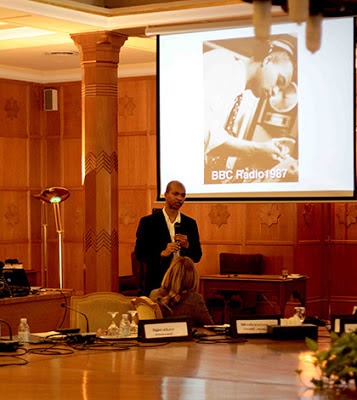 |
| David arrives early at the judging meeting at the RTS |
The winning entry for this year's innovative news read as follows on the RTS's website
Innovative News
No Go Britain, ITN for Channel 4 News
“The winning entry stood out for the novel way in which it helped to give a new look at one of the year's big stories. It built upon the strength of crowd sourcing and social media and then added the clout of a broadcaster to build up the channel's continued commitment to people with disabilities in the year of the Paralympics.”
The Nominees were:
- 50 States: 50 Voices, Sky News
- The Olympic Torch Relay, BBC News for BBC
Within the glitz, as well as, sombre mood from remembering fallen journalists, the industry gathered at the Hilton to crown the victors. A couple of months earlier, however, the business of finding a winner and why fell to ten of us gathered at the RTS headquarters in central London.
Jurors are pulled from across the industry, as well as academia, from where I come. It's an interesting area to diagnose. What does constitute 'innovative'? We have guidelines and the mood is relaxed, yet business like to soul search, if the need arises.
So why me, how did I get involved? I can't be sure. There's a panoramic look across industry for people with the skill, and presumably, the fact I have worked for BBC, Channel 4 News, WTN, ABC News and a host of others might suggest I possess some understanding of the broadcaster's production process.
Now, it would be grossly unprofessional to write about our conversations when judging, in that common courtesy alone dictates I should at the very least contact my fellow jurors. I also feel a bit of
Chatham House rules applies to be frank about our conversations, so I will only reflect on my thoughts on 'No Go Britain' and what caught my interest. I'll do the same for '50 States' and 'The Olympic Torch Relay'.
Also, a myth buster to friends who have asked. The voting is such that I genuinely have no idea who has won, until it's announced on the night.
No Go Britain
 |
| Awards Night at the Hilton |
'No Go Britain' did something that broadcasters rarely have time for, because of the news agenda. They took an off diary event, that is people with difficulties getting across London because of disabilities and contextualised it via a bit of advocacy journalism. Or as Katie Razzall, C4 reporter put it: 'This was about empowering disabled people to lobby for change'.
The plight of anyone disabled trying to get by on London transport may seem anecdotal or at best isolated, but the programme followed a couple of subjects around as they negotiated their way across the capital, evoking Robert Drew's mantra of 'being there'. But how did they get their subjects or begin to understand how deep the issue went? Old media and the not so new in twitter collided.
The twitter discourse allowed the programme to pull the issue together. and once it turned from tweets to taped interviews, the subjects within the film were invited to speak on the programme. The shift had been made now to good robust studio debate. It could have been left here, but the producers now made the issue an open platform for the disaffected to meet and discuss on air with execs.
If there's one thing new media by itself still has yet to do well, its the clout and platform to call on high profile interviewees, in this case transport bosses and let them face their accusers. When John Major, from the Confederation of Passenger Transport spoke about changes that would take place in 2017, presenter Jon Snow tells us of an audible gasp from panelists, before Anthony Wilson quips: we live in 2012, not 2017. Good television.
Channel 4 News then announced it would be taking on further campaigns and execute a similar strategy. So what made it innovative? Tying all those elements together rather swiftly, mixing old and barely new media. Twitter was not incidental, but strategic.
A couple of years earlier CNN used twitter for the world cup in an innovative means. Nope, this doesn't mean you need twitter to impress. But C4News made it look integrated. Other factors included: letting the stakeholders tell the story, finding strong interviewees who could articulate their concerns and were not fazed by the studio or even the execs they were meeting.
Finally looking at the workflow, it appeared seamless and the thought did cross my mind of the strategic use of resources and personnel.
As an acad-ournalist or hack academic ( both horrible words) a critique, such as this will hopefully provide ideas for up and coming practitioners, online media and Masters students looking to understand programme making. C4 News provided a text book case on how to leverage a story. I might have gone slightly further with the videoing, using the Go Pro 3 so the subjects could bring back vérité videos of the troubles they face, but that's a moot point.
Tomorrow I'll talk about 50 States and The Olympic Torch.
Click here for previous posts
 |
| David in Tahrir Square, February 19th 2013 |
 |
| David in Chongqing working with universities |
On another related matter I am convinced that Chinese narrative, with its multiple foci in painting, holds an important understanding for elliptical narratives and new media story form.
 |
| Speaking at NewsXchange in Barcelona |
























